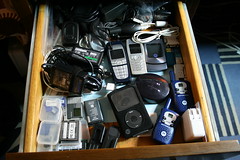[Professorial Lecture series post five]
“Technology is like a fish. The longer it stays on the shelf, the less desirable it becomes” – Andrew Heller; lead IBM RS6000 team
The odds are pretty good that every one of you has an old cell phone in a drawer at home, or perhaps even a gadget drawer that looks like the image on the right. Our house has four. You may may keep old devices just in case something happened to your new one, or maybe you just didn’t know what to do with it. As technologically evolves at an ever-increasing pace the practice of discarding technological devices for shinier models with new and different features has become a part of our lives. As you will see, this applies to scholarly communications as well.
The technology life-cycle begins with invention of a specific technology, continues though a process of continuous improvement, and ends with how the technology is eventually diffused to the end user. The phrase bleeding edge is often used to describe the early adoption of a technology while the laggards are the last to adopt. The Tipping Point is the moment when an idea, trend, or social behavior crosses threshold, tips, and becomes popular and commonplace. Consider just 10 years ago:
- The First commercial deployment of camera phones in North America
- Dell Digital Jukebox “almost as good as” the iPod
- Facebook was released at Harvard
- YouTube was 1 year away
- iPhone and Android operating system were still 3 years away
Each year, the Gartner group releases it’s technology Hype Cycle. It is a continuum of where various technologies are in the hype cycle. Like with Gopher, many technologies will become obsolete before they even reach the tipping point. Keeping an eye on what is coming up on the horizon is sometimes more important than knowing the ins and outs of each technology. Many times it is not a single technology but a combination of technologies that when used together become a viable solution.
As Clayton Christensen discussed in his dissertation turned best seller The Innovator’s Dilemma, technologies are either sustaining or disruptive. Sustaining technologies improve a current product performance thorough increased efficiency. Disruptive technologies are often those where the ultimate use or impact is unknown at the time of release. Gopher was a sustaining technology since it really improved upon FTP. While in many ways Mosaic was a sustaining technology it was also disruptive since at the time of release we didn’t fully understand its potential for scholarly communications. In libraries, the online catalog was both sustaining and disruptive. It sustained the classic card catalog structure but disrupted how users could access resources.
The dilemma that the rapidly changing technology landscape at that time presented was trying to identify which emerging technologies could be used to sustain current models of scholarly communication and which technologies would creating disrupting models. Not only how would the technologies be identified, but how could the be used to keep scholarship in the discipline of librarianship relevant in a rapidly changing technology and communications environment.
